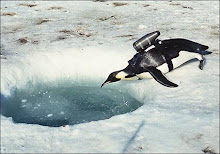Basically, inventory is down a bit everywhere. I hear quite a few people talking about waiting (up to 3 years) for when the market improves. Hmmm... could this be one of the reasons real estate recovers after a drop so slowly? ;)
National inventory says that nationally we should expect another year like 2008. However, at this point in the economic cycle one would expect layoffs to be driving home prices. Thus one will feed the other. Everything I look at points to 2009 being the worst year in home prices in US history. Yes... worse than 1931.

So I'll start the inventory with the two cities that should have the least downside risk. Now, we've watched their ex-urbs get hit, so I expect 'substitution' to pull down the center. But I'm not expecting a huge drop in either unless employment does even worse than this bear is being too optimistic. I see a chance of at most a 20% drop for both, with the worst areas being those alleged immune high end areas where we'll find out the poseurs in 2009. Most of the downside for these two areas will be due to the tightening of credit and some job losses.

I'll switch to a city that I think will be in the Running for the worst Real Estate market in 2009. Other contenders are Las Vegas, Palm Beach Florida, and Phoenix. This is my home city of LA. While nominal inventory is going down... Look at the malls. Not just all of the new ones going up, but the empty stores at the existing.
Greater LA is a metropolis that has many industries, but too many are running off advertising revenue. I assume you have been following the trend in that LA is doing fewer movie and TV shoots (minutes of filming) and more advertising. Hmmm... Add budgets are down... and just how much of Santa Monica is employed in internet companies dependent on ad revenue? I still see a 35%+ downside for SoCal.

The South Bay portion of LA is where I wish to buy. Less ad revenue dependent than 'the Westside', but it will be hit by that downturn too. It is also the US home of Aerospace engineering but it is looking at budget cuts and that means salary cuts. Aerospace will lose a minimum of 20,000 jobs in the South bay between now and Christmas 2009. :( It could be as high as 50,000. Yikes! So hang on, there is a bumpy ride ahead.

The housing bloggers have been obsessed with Phoenix for years. Inventory remains persistent above 60,000. It will be healthy again once its below 30,000! Something like 40% of Phoenix's peak employment was working to grow the city. The joke was that it is a city where Plumbers build homes for Roofers and Realtors. Possibly on Las Vegas and Palm Beach truly have as much downside risk.
Part of the reason I'm bearish nationally as too many high population states are going down. No bailout will help. In fact, the bailouts are only keeping the builders building and this increasing the downside potential everywhere there was building (which is... everywhere!).

A little more discussion on SoCal. Over HALF of sales are now foreclosures, yet the banks are still selling foreclosures slower than they are building up on the books! This is a doomsday scenario: Declining jobs and a monster inventory overhang. Oh... If you think your area is immune, what exactly was all the media coverage about 'California equity locusts' about if we weren't driving up prices everywhere! Seriously, every area will drop to where its incomes can support housing.

Oh... to think that the people who know bonds are speculating that during the summer of 2009 the government will lose its ability to keep propping up the economy. Bond buyers are supposed to be skeptical... there is enough momentum to keep things going for a bit. So the transition to Capitulation might not happen until this summer bond event. Cest la vie. Its going to happen. That will put those with savings in a very good space. :)
Got Popcorn?
Neil


